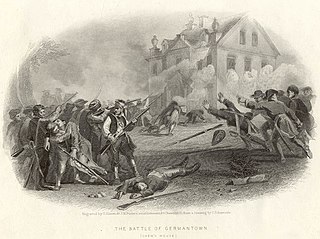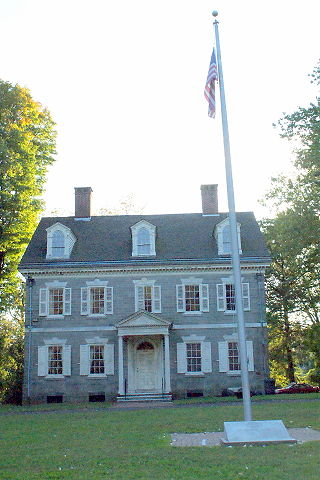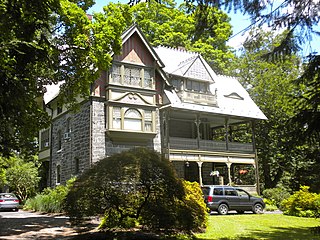
Germantown is an area in Northwest Philadelphia, Pennsylvania. Founded by Palatine, Quaker, and Mennonite families in 1683 as an independent borough, it was absorbed into Philadelphia in 1854. The area, which is about six miles northwest from the city center, now consists of two neighborhoods: 'Germantown' and 'East Germantown'.

Mount Airy is a neighborhood of Northwest Philadelphia in the U.S. state of Pennsylvania.

The Germantown White House is a historic mansion in the Germantown section of Philadelphia, Pennsylvania. It is the oldest surviving presidential residence, having twice housed Founding Father George Washington during his presidency.

The Colonial Germantown Historic District is a designated National Historic Landmark District in the Germantown and Mount Airy neighborhoods of Philadelphia, Pennsylvania along both sides of Germantown Avenue. This road followed a Native American path from the Delaware River just north of Old City Philadelphia, through Germantown, about 6 miles northwest of Center City Philadelphia, and on to Pottstown. Settlement in the Germantown area began, at the invitation of William Penn, in 1683 by Nederlanders and Germans under the leadership of Francis Daniel Pastorius fleeing religious persecution.

Stenton, also known as the James Logan Home, was the country home of James Logan, the first Mayor of Philadelphia and Chief Justice of the Pennsylvania Supreme Court during the colonial-era governance of the Province of Pennsylvania. The home is located at 4601 North 18th Street in the Logan neighborhood of North Philadelphia.

Grumblethorpe was the home of the Wister family in the present-day Germantown section of Philadelphia, who lived there for over 160 years. It was built in 1744 as a summer residence, but it became the family's year-round residence in 1793. It is a museum, part of the Colonial Germantown Historic District.

Beggarstown or Bettelhausen was a small community that was located in the present day neighborhood of Mount Airy in Northwest Philadelphia in the U.S. state of Pennsylvania. It centered primarily along a stretch of relatively flat land along Germantown Avenue roughly between Upsal Street and Gorgas Lane.

Cliveden, also known as the Chew House, is a historic site owned by the National Trust for Historic Preservation, located in the Germantown neighborhood of Northwest Philadelphia. Built as a country house for attorney Benjamin Chew, Cliveden was completed in 1767 and was home to seven generations of the Chew family. Cliveden has long been famous as the site of the American Revolutionary War's Battle of Germantown in 1777 as well as for its Georgian architecture.

The Wyck house, also known as the Haines house or Hans Millan house, is a historic mansion, museum, garden, and urban farm in the Germantown neighborhood of Philadelphia, Pennsylvania. It was recognized as a National Historic Landmark in 1971 for its well-preserved condition and its documentary records, which span nine generations of a single family.

Upsala is a historic mansion in Mount Airy, Philadelphia, Pennsylvania, United States. Considered one of the finest extant examples of Federal architecture, the mansion is a contributing property of the Colonial Germantown Historic District and is listed on the National Register of Historic Places and the Philadelphia Register of Historic Places.

Historic RittenhouseTown, sometimes referred to as Rittenhouse Historic District, encompasses the remains of an early industrial community which was the site of the first paper mill in British North America. The mill was built in 1690 by William Rittenhouse and his son Nicholas on the north bank of Paper Mill Run near Philadelphia, Pennsylvania. The district, off Lincoln Drive near Wissahickon Avenue in Fairmount Park, includes six of up to forty-five original buildings. RittenhouseTown was listed on the National Register of Historic Places and was designated a National Historic Landmark District on April 27, 1992.

The Chestnut Hill Historic District is a historic area covering all the Chestnut Hill section of Philadelphia, Pennsylvania.

The Ebenezer Maxwell House, operated today as the Ebenezer Maxwell Mansion, is an historic house located in the West Germantown neighborhood of Philadelphia, Pennsylvania.

The Old Germantown Academy and Headmasters' Houses or The Old Campus is an historic, American school campus, the original site of Germantown Academy, located at Schoolhouse Lane and Greene Street in Philadelphia, Pennsylvania. The academy moved to a new suburban location in 1965, and the site is currently occupied by the Pennsylvania School for the Deaf.

The Concord School House is a historic one-room schoolhouse in the Germantown section of Philadelphia, Pennsylvania. It is operated today as a museum. It is part of the Colonial Germantown Historic District which was named a National Historic Landmark District in 1965.

The Widow Maloby's Tavern is an historic, American tavern building that is located in the Queen Village section of South Philadelphia, Pennsylvania.

Charles Schaeffer School is a historic former school building located in the Germantown neighborhood of Philadelphia, Pennsylvania. The building was renovated in 2019 and is now the corporate offices of the Philly Office Retail real estate company.

Franklin Hose Company No. 28, also known as Harmony Engine Company No. 6, is a historic fire station located in the Southwest Center City neighborhood of Philadelphia, Pennsylvania. It was originally built about 1849, and considerably altered with a new front in 1868–1869. It is a four-story, three-bay-wide building measuring 34 by 60 feet. It is constructed of brick, with an ashlar granite-faced first story and a mansard roof. It features round arched window openings and a heavy wood cornice. In February 2010, the building was undergoing renovation.

Chester Springs Historic District, also known as The Old Art School, Orphan's School, Yellow Springs Spa, and Good News Buildings, is a national historic district located in West Pikeland Township, Chester County, Pennsylvania. The district includes 7 contributing buildings, 1 contributing site, and 1 contributing structure in the spa community of Chester Springs. The district includes the old hotel and inn, two large residences, a bath house at one end of the springs, and a studio. It also includes a wooden summer house that enclosed the iron springs. The property was the site of a hospital commissioned by the Continental Congress and built in 1777. The three-story, 106 feet by 36 feet wide building burned in 1902, was reconstructed, then burned again in the 1960s. The Yellow Springs resort operated in the early-mid 19th century and many of the buildings date from that period.

St. Michael's Evangelical Lutheran Church is a historic church building in the Mount Airy neighborhood of Philadelphia, just north of the Germantown neighborhood. The congregation was founded sometime before 1728 and three successive church buildings have occupied the same location since that time. The church was closed in 2016.
























